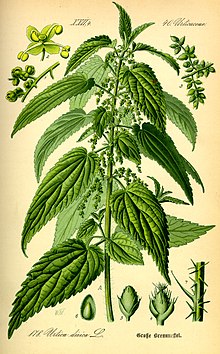Urtica
| Nettle | |
|---|---|
 |
|
| Stinging nettle (Urtica dioica) | |
| Scientific classification | |
| Kingdom: | Plantae |
| (unranked): | Angiosperms |
| (unranked): | Eudicots |
| (unranked): | Rosids |
| Order: | Rosales |
| Family: | Urticaceae |
| Genus: |
Urtica L. |
| Species | |
|
See text |
|
See text
Urtica is a genus of flowering plants in the family Urticaceae. Many species have stinging hairs and may be called nettles or stinging nettles, although the latter name applies particularly to Urtica dioica.
Urtica species are food for the caterpillars of numerous Lepidoptera (butterflies and moths), such as the tortrix moth Syricoris lacunana and several Nymphalidae, such as Vanessa atalanta, one of the red admiral butterflies.
Urtica species grow as annuals or perennial herbaceous plants, rarely shrubs. They can reach, depending on the type, location and nutrient status, a height of 10–300 cm. The perennial species have underground rhizomes. The green parts have stinging hairs. Their often quadrangular stems are unbranched or branched, erect, ascending or spreading.
Most leaves and stalks are arranged across opposite sides of the stem. The leaf blades are elliptic, lanceolate, ovate or circular. The leaf blades usually have three to five, rarely up to seven veins. The leaf margin is usually serrate to more or less coarsely toothed. The often-lasting bracts are free or fused to each other. The cystoliths are extended to more or less rounded.
In 1874, while in Collioure (south of France), French botanist Charles Naudin discovered that strong winds during 24 hours made the stinging hairs of Urtica harmless for a whole week.
...
Wikipedia
